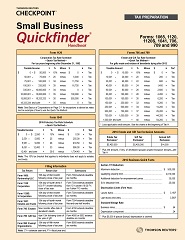We're available Monday to Friday from 8 a.m. to 6 p.m. eastern time.
Need help right now? Call 1-800-431-9025.

The 2025 Small Business Quickfinder Handbook will be available in December 2025. Pre-order your Handbook today.

The Small Business Quickfinder Handbook is your trusted source for quick reference to tax principles that apply when preparing business and fiduciary income, estate and gift, tax-exempt organization, and payroll tax returns. It covers the essentials of preparing these tax filings, including detailed, true-to-life examples with filled-in forms and line-by-line explanations, and thoroughly addresses tax law changes and IRS developments, all in a concise, easy-to-use format.
From start-up to termination issues, and everything in between - including employee benefits, accounting methods and principles, deductions, credits, and tax planning - this Handbook is a unique, one-stop solution for your many tax questions.
Here’s what you’ll get with this useful tool:
See information above for new edition availability. To order the current or prior tax year editions, please call us at 800-431-9025.